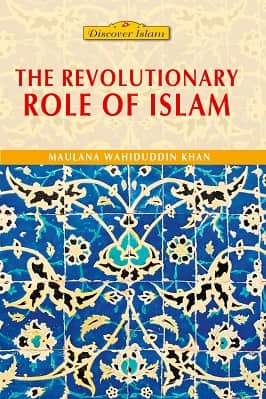
| The Revolutionary Role Of Islam |
| Maulana Wahiduddin Khan |
| 23 |
| |
| PDF Direct Download Link |
| Click for Hard Copy from Amazon |
The Revolutionary Role of Islam
THE REVOLUTIONARY ROLE OF ISLAM
…Prophet Muhammad, may peace be upon him, one of the distinguished members of the Banu Ismail, struggled for about thirteen years in Makkah and ten years in Madinah.
Ultimately, more than one hundred thousand people believed in him and joined his mission. Each and every one of his companions possessed a strong and dependable character.
In this way Prophet Muhammad, may peace be upon him, in an exceptional way, secured a team by which he could bring the message of the prophets to fruition—taking the prophetic mission from the theoretical stage of ideology to the practical stage of revolution.
The next part of this divine plan consisted of weakening these anti-monotheism forces so considerably that the last Prophet might subjugate them and usher in the desired revolution in the very first generation itself.
To achieve this end, the Arabian tribes remained engaged for a long period of time in bloody, internecine warfare. Consequently, when Prophet Muhammad, may peace be upon him, was sent to the world, the idolatrous tribes of Arabia, having so weakened themselves, could not continue their resistance for long.
This enabled Prophet Muhammad, may peace be upon him, to overcome Arabia and root out idolatry completely within a short period of time.
In those days there were two great empires outside of Arabia. These empires kept the major parts of Asia and Africa under their full control.
Their power was so great that the Arabs could not even have dreamed of overcoming them.
Despite this extremely out of proportion difference, how did it become possible for the Arabs of the very first generation, to conquer both these empires—the Sassanid and Roman—in such a decisive way as to crush them absolutely, resulting in the dominance of monotheism over idolatry throughout this region?
This miracle became a reality owing to a special divine strategy, which is paralleled by the case of the Romans:
The Romans have been defeated in a neighbouring land. But after their defeat they shall themselves gain victory within a few years. (Quran, 30:1-3)
History shows that from 602 to 628 A.D., extremely extraordinary events took place between these two great empires.
First, the royal families in the respective countries clashed internally with one another, and in consequence, many individuals of great political
Worth were killed. Infact, these feuds gavea death blow to these empires, shaking them to the very roots.
Subsequently, certain factors led to the destructive collision of these empires with one another. First the armies of the Sassanid Empire crossed the border of the Roman Empire to attack it. Circumstances proved favourable and they succeeded to the extent that the Roman Emperor Heraclius decided to flee from his Palace in Constantinople. But again, events took a new turn.
Heraclius regained his lost confidence and after making full preparations, attacked the Sassanid Empire, destroyed their armed forces and penetrated right into the heart of Jerusalem.
These civil wars, lasting for about twenty-five years, considerably weakened both these empires.
Therefore, during the pious caliphate when the Arab forces entered the Roman and Sassanid empires, they managed to advance with great speed.
Historical Revolution
This expansion of the Islamic empire was not simply a political event. Its aim, in fact, was to set in motion a revolutionary process in history.
This process had been initiated in Makkah itself, then it traveled from Makkah to Madinah, to Damascus and Baghdad from where it entered Spain and thereafter it spread all over Europe and the entire world.
We would probably be right in saying that the 20th century saw the culmination of this process.
There are two basic aspects to this movement. One was the end of religious persecution. (This kind of persecution has been mentioned in the Quran as ‘fitna’). (8:39)
The process began with the end of idolatry and was completed during the lifetime of the Prophet.
The other, the advent of religious freedom, came about later, during the pious caliphate; with the disintegration of the two great empires—the Sassanid and Byzantine—the two greatest pillars of religious persecution were uprooted, and religious freedom became the order of the day.
However, no great revolution materializes all of a sudden. It reaches fruition only by a long historical process, and the Islamic revolution was no exception to this rule.
The process of human liberation, initiated by Islam, continued over a long period to make advances through individual and collective efforts, taking various forms.
The second Caliph, Umar Faruq (d. 644) addressing one of his governors and his son in a well known case asked: “Since when have you enslaved people while their mothers had given birth to them in freedom?” (Al-Abqariat Al-Islamia).
To read more about the The Revolutionary Role Of Islam book Click the download button below to get it for free
or
Report broken link
Support this Website
for websites